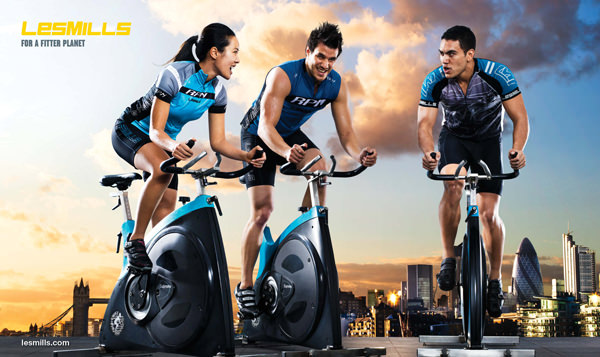Les Mills is a fitness regimen that covers what the company believes is needed to give gym goers an overall fit body. Within the Les Mills family is an indoor cycling class called RPM, which can be fun. Like other indoor cycling classes, it depends on the energy given by the instructor. We check it out so you know what to expect on your first, or subsequent, visits.
What is Les Mills RPM?
Choreography is already in place, so every instructor teaches the same tracks and gives the same overall workout. Unlike more traditional classes, RPM has its own positions. Instead of first, second, and third position it uses “ride easy,” “standing climb,” “power climb,” “aero racing,” and “standing attack.” These positions allow the rider to better utilize both the quads and the hamstring muscles while keeping the core active.
Anyone who has ever been to an indoor cycling class can probably testify that the first time they were told to “engage your hamstrings” in second position it was very challenging!
You’ll notice a series of numbers following each Les Mills RPM class title, like 57, 58, 59. Those are actually the release or episode number. Currently the most recent release is 59. All this means is the choreography is a little different and the music is different.
Cons of Les Mills RPM
A downside to RPM is that instructors are not allowed off the bike while teaching. This can lead to improper form with no adjustments if you, as a rider, are not receptive to verbal cues.
What to Expect in a Les Mills RPM Class
The breakdown of the class is simple: Nine tracks, six of them being working tracks. The entire class lasts around 50 minutes front to back. By the end of class your legs should be feeling the fruits of your labor.
With a team of trainers who design every release, it is well programmed. At its core is a style of High Intensity Interval Training (HIIT). You’ll find yourself working anywhere from 30 seconds up to 1 minute, with a 20-30 second rest in between. As you add resistance, your resting period becomes increasingly challenging.
What Does This Do to Your Body?
Simple. It mainly works you through your first two energy systems, known as your “Adenosine Triphosphate Phosphocreatine” (ATP/PCr) and your “Glycogen” system. Both of these systems work without the presence of oxygen (anaerobic), meaning they provide very short-term energy. While you will be using your aerobic energy system overall, with every push you will spike these anaerobic energy systems.
To give you an example of the effects, take the person at the gym whom you see every day for 2-3 hours. (No, not the trainer.) Day in and day out this person is there doing one long workout, barely breaks a sweat, and doesn’t ever seem to change physically. It’s not that effective because they aren’t using their energy systems effectively. They stay at a constant intensity. Now think of that person who comes into the gym, bangs out a workout in no time, and afterward looks like they NEED a rest. They get results because they’re training their energy systems effectively. That is what RPM is doing. Short and sweet, and it gets the job done.
The more resistance you add, the more calories you’ll burn. While calories burned is based off an equation based off of weight, heart rate, and body fat, I have seen people burn up to 400 calories or more at a Les Mills RPM class. However, this number will vary by individual.
RPM can be a very important addition to anyone’s fitness regimen. Instead of going on a treadmill and running at a constant pace, it pushes you to adapt to new challenges.
Should You Try It?
I recommend this class to my clients because the programming lets me know the class won’t be hard just for the sake of being hard.
Also Read:
13 Hot New Workouts to Try This Summer


How does RPM intensity differ from other cycling classes that do alternating HIIT and endurance classes??